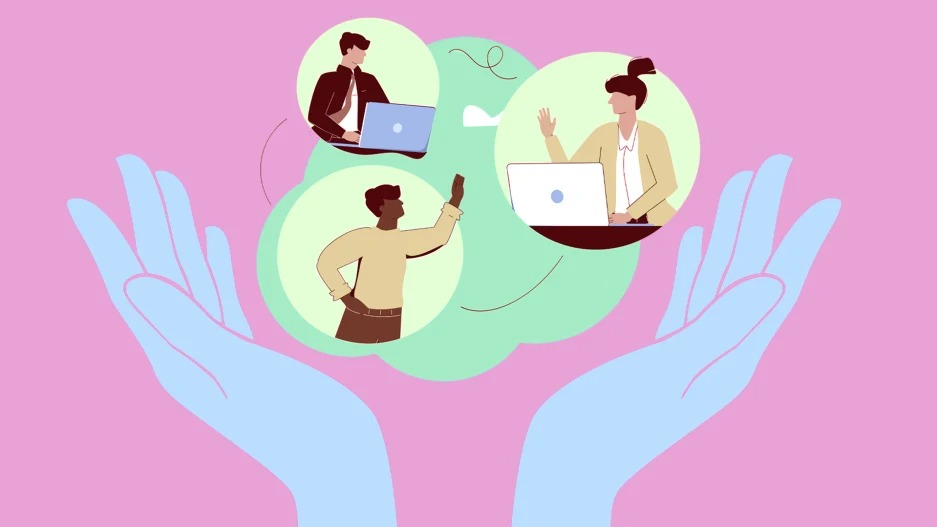- | 4:00 pm
5 simple ways leaders can practice being more inclusive
Santander US chief diversity officer explains how centering DE&I efforts around human connection and psychological safety will build more inclusive organizations.

Consider two employees entering an office today. One of these workers has a job deemed “essential” and is in the office full time, as she has been throughout much of the pandemic. The other worker, after spending the better part of two years working from home, now has a hybrid role and works in the office two days per week. These employees share the same race, the same gender, and the same educational background. As they enter the building lobby, one introduces herself to the other. They quickly discover that they work in the same department, though they have never met.
Sound familiar? Scenes like this are taking place every day in the American workplace and will be common occurrences for years to come. They are examples of the new work landscape that companies and workers are experiencing together.
Three years into the pandemic, they are unearthing important questions: Do these people both feel included and valued? Will the woman who works at the corporate facility in person all the time have opportunities not afforded to the hybrid worker? What—if anything—do these women do differently now that they realize they are teammates?
With limited opportunities to build trust and camaraderie in a hybrid-work environment, addressing new issues such as proximity bias will require a new approach to building an inclusive workplace. As we navigate new ways of working, we must evolve our thinking around diversity, equity, and inclusion (DEI), understanding the increasingly important role that inclusion plays in employee self-awareness and worth, retention, and opportunities for growth.
While much about our lives today seem almost pre-pandemic “normal” (stores are open, diners fill restaurants, buses and subways are bustling), most people will tell you that nearly everything about work has changed. With a continued strong job market, employees are reflecting on their value and whether they are valued, and studies show that employees will seek out jobs with purpose and a work environment that contributes to their feelings of fulfillment.
In the past, we’ve thought of inclusion as a sense of belonging and have seen results by focusing on inclusion as the starting point, realizing that diversity is the outcome, and equity is how we get there. Let’s call this Inclusion 1.0.
The second iteration—Inclusion 2.0—saw many organizations lean in to support employees through organized advocacy groups, giving employees a voice and a platform to shine a light on both commonalities and barriers to success. These inclusive actions began for many organizations pre-pandemic, and became even more important following the onset of the pandemic.
In 2023 and beyond, organizations will have to adapt to a new mindset around inclusion. There are things we must unlearn from the early days of corporate DEI, shifting our mindset away from the vanity metrics and buzzwords that have framed many legacy DEI programs.
Inclusion 3.0 will focus on human connection and promoting psychological safety, where employees feel safe to speak up, learn, and contribute at work.
HOW TO PRACTICE INCLUSION 3.0
What can organizations do to build trust with employees to create an environment where employees feel seen, heard, and valued for exactly who they are?
It starts from the top down and requires planning with intention. Here are five fundamentals to consider:
- Leaders must focus on vulnerability, authenticity, and cultural curiosity. Leaders should be role models for inclusion and create safe spaces for discussion, sharing honestly about challenges people face both inside and outside of work.
- Create platforms for human connection to form connections that are deeper than just the work to be completed. Lunch round-robin discussions, virtual and in-person community service, or health and fitness interest groups leading to shared experiences and rich conversations.
- Start or end meetings with opportunities to connect. Ask pairs of employees who don’t know one another to find one thing they have in common. It will be harder than you might imagine for them to stop talking once they start.
- Use analytics to be predictive and better understand root causes hampering inclusion. For example, if you desire to set a benchmark for hiring more Latine attorneys, it is helpful to understand how many Latina attorneys are coming out of law schools. Move beyond engagement surveys to facilitate human connection. If a team’s score is reasonable but their attrition rate is an outlier, dig deeper to find out why.
- Prioritize all components of psychological safety; not just the sense of belonging but the ability to speak up. There are four stages of psychological safety:
- Inclusion safety: members feel safe to belong to the team.
- Learner safety: members are able to learn through asking questions.
- Contributor safety: members feel safe to contribute their own ideas.
- Challenger safety: members can question others’ ideas or suggest significant changes.
At Santander US, over the past 18 months, we’ve been putting into practice programs centered around human connection that are helping us on our journey toward Inclusion 3.0.
Our “Mentorship for All,” program pairs mentors with employees who otherwise would not have had the opportunity for mentorship. Establishing regional leads for remote/hybrid colleagues in our employee Business Resource Groups has given employees outside our corporate centers a voice.
A focus on social innovation (partnerships vs. philanthropy) helped us stand up digital and financial inclusion programs in our communities, and established industry advocacy groups for minority customers. Perhaps most impactful in our daily work is our move to a consistent model of leadership and staff collaboration in addressing business challenges and problem-solving.
Inclusion 3.0 requires organizations to shift from traditional ways of thinking to focusing on belonging. Centering DE&I efforts around human connection and psychological safety will force the necessary paradigm shift to meet future societal changes and build more inclusive organizations.






































